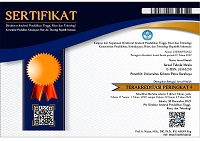Desain Eksperimen untuk Mengoptimalkan Proses Pengecoran Saluran Keluar Teko
Keywords:
casting, experiment design, factorial design, response surface, optimizationAbstract
The most frequently found defect in the casting process of making teapots out flue is that the outlet is too narrow or even blocked at the end of the casting process. There are many factors influence that defect. This defect condition can be represented as the thickness of the casting product. In this paper, the significant factors that influence the thickness of the out flue resulted from the casting process will be analyzed and further got their optimum conditions. Design experiments methods will be implemented here, especially the factorial design method to determine the significant factors along with their optimum conditions. Also, the response surface method will be applied to obtain the approximation model for the thickness of the out flue as a function of the factors found earlier so that the most optimal result can be obtained under a design optimization method. It is concluded from the experiments results and analysis that the significant factors for the thickness of out flue are pouring temperature, sprue radius and holding time. The optimum conditions of those factors are 475°C, 29.6 mm and 8 seconds respectively with 2.54 mm thickness. Abstract in Bahasa Indonesia : Kondisi cacat yang paling banyak dijumpai pada proses pengecoran saluran keluar teko adalah lubang saluran keluar pada ujung teko yang terlalu sempit bahkan tertutup di akhir proses pengecoran. Banyak faktor yang mempengaruhi proses pengecoran ini sehingga menyebabkan cacat tersebut. Kondisi cacat ini dapat direpresentasikan dengan ketebalan dari produk cor saluran keluar teko. Pada makalah ini akan dianalisa faktor yang paling signifikan mempengaruhi ketebalan saluran teko hasil cor. Metode yang digunakan adalah metode desain eksperimen khususnya metode desain faktorial untuk menentukan faktor-faktor yang signifikan serta kondisi optimumnya dan metode response surface untuk mendapatkan model pendekatan untuk ketebalan saluran teko sebagai fungsi dari faktor-faktor tersebut sehingga dapat diperoleh kondisi keseluruhan yang paling optimal. Dari analisa hasil eksperimen ini ditemukan bahwa faktor yang signifikan terhadap ketebalan adalah temperature tuang, radius sprue dan holding time. Dapat pula disimpulkan bahwa kondisi optimum dari factor-faktor tersebut adalah temperatur tuang 475°C, radius sprue 29.6 mm dan holding time 8 detik yang menghasilkan ketebalan sebesar 2.54 mm. Kata kunci : pengecoran, desain eksperimen, desain faktorial, response surface, optimasi.Downloads
Published
2004-07-01
Issue
Section
Articles
License
Jurnal Teknik Mesin diterbitkan oleh Universitas Kristen Petra.
![]()
Artikel dan semua materi yang diterbitkan terkait didistribusikan di bawah Lisensi Internasional Creative Commons Attribution License (CC BY).


















